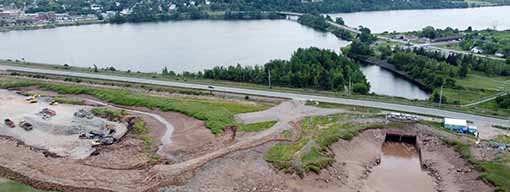FOR IMMEDIATE RELEASE
July 14, 2021
The Assembly of Nova Scotia Mi’kmaw Chiefs (Assembly) is calling on Nova Scotia to ensure that any long-term or interim plans being put into place on the Highway 101 twinning project, focus on unimpeded fish passage, for all species. As completion dates continue to be pushed by the province, Mi’kmaw concerns on fish and fish passage remain.
In 2019, the planned completion date for the Highway 101 twinning project from Three-Miles Plans to Falmouth, was fall 2022, yet the province’s determination to maintain a freshwater reservoir has now delayed the project completion date by at least a year, to December 2023.
The Assembly has stated repeatedly that any river crossing infrastructure at the Avon River must provide unimpeded fish passage for all species, 365 days a year, and they have also stressed how imperative it is to restore sufficient tidal flow to eliminate human operation and future manipulation of fish passage.
“Despite what we’ve said and the expert environmental advice that the province has received, Nova Scotia continues their attempt to maintain a freshwater reservoir above the Windsor Causeway at the expense of fish passage, the ecosystem and our Rights,” said Chief Gerald Toney, Fisheries Lead for the Assembly. “Nova Scotia’s plan to address the environmental concerns with this project is incomplete and inadequate. It is beyond time for Nova Scotia to remedy this situation.”
After an apparent extensive review of the proposed plan, the Department of Fisheries and Oceans Canada’s (DFO) response also echoed the concerns brought forward by the Assembly through the Mi’kmaq-Nova Scotia-Canada Consultation Process.
“Even DFO agreed that Nova Scotia’s proposed plan was incomplete and inadequate,” continued Chief Toney. “In order to complete the highway twinning project and alleviate public safety in a timely manner, the province must construct highway bridges designed to withstand full tidal exposure, rather than waiting for the construction of a new gated structure that may never receive regulatory approvals.”
The Assembly insists that the existing structure remains in place, with the gates controlled by the Ministerial Order currently put in place, until an option that provides adequate fish passage can be found and agreed upon by all parties.
“We can’t continue to wait for Nova Scotia to figure out what works best for them. They must do what works for the fish and the environment now,” said Chief Toney.

